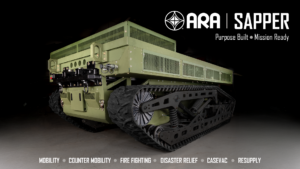Microrobots have the potential to provide patients with targeted therapies, reducing drug side effects and improving efficacy.
ARA has developed a control system for precisely navigating microscopic robots (microrobots) within biological fluids and is currently seeking medical research collaborators to grow the technology into medical applications.
Dr. Louis William Rogowski, an ARA research scientist and expert in the field of microrobotics, answered six questions about the potential use of microrobots in medicine and ARA’s mission to push the boundaries of microrobotics research.
Q: What is microrobotics?
A: Microrobotics is the study and development of robotic systems that are smaller than a millimeter in size. Microrobots developed from this research have the potential to provide targeted lifesaving treatments without the need for invasive surgery. For a sense of scale, we typically work on microrobots that are much smaller than the diameter of a single human hair.
Q: What kind of applications could microrobotics have?
A: Due to their small size, microrobots could be leveraged for numerous applications from pharmaceutical research to data encryption & defense. Specifically, within the field of biomedicine, microrobots could be used to provide alternative treatment options, like minimally invasive surgery and targeted drug delivery. One example is improving chemotherapies, whereby anti-cancer drugs are loaded into a microrobot platform, navigated to a tumor site in the body, and made to release the drugs in a highly targeted manner, reducing overall side effects and shortening patient recovery times. Another example is heart surgery, where microrobots could be used to de-clog an artery without the risks involved in invasive surgery. While these applications are still long-term goals, they do a good job of highlighting the potential benefits of the technology. Achieving this potential is what drives research teams across the world, ARA included.
Q: What has accelerated microrobotics research and the use of microrobotics technology in recent years?
A: If I had to point to any one thing, I would say that social media has been the biggest driver. There has always been broad academic interest in microrobotics technology since its inception. In his famous 1959 talk “There’s plenty of room at the bottom,” Dr. Richard Feynman theorized technology would get so advanced, you would literally be able to “swallow the surgeon.” This inspired movies like the 1966 film ”Fantastic Voyage,” where a small-scale vehicle was shrunk down with doctors and used to treat a patient. In recent years, social media has really become a blessing to the field, with research scientists able to not only quantify microrobot behavior scientifically but also demonstrate their capabilities in a visually compelling way. When I met my PhD advisor, Dr. Min Jun Kim (BAST Lab, SMU), I was shown a video of bacteria that had eaten iron particles and were then being magnetically guided with a control system. After seeing this I was hooked for life. It’s one thing to talk about the theoretical potential of microrobots, but it’s very different when you are shown a video of a microrobot swimming towards a cancer cell and deploying a drug payload. It’s even better when you can physically hand someone an Xbox controller and watch their eyes light up as they realize they are moving microrobots around in real life. Microrobotics technology still has a lot of challenges to overcome, but it has entered a transition period, with renewed public interest combined with good science helping mature the technology into medical and industrial settings.
Q: How do you envision the future of microrobotics in medicine?
A: Long term, it is my vision that microrobotics technology will not only provide health benefits to civilians but also support the recovery of injured soldiers in the field. Of the 310 million major surgeries that occur globally, 15 percent of patients experience post-operative morbidities, 5 to 15 percent of patients require re-admission, and 1 to 4 percent of patients die within 30 days. Microrobots have the potential to reduce the severity of these surgeries, limit adverse side effects from drug regiments, and foster an overall healthier society. Developing tools to accelerate the treatment and recovery of combat injured U.S. service members will also help elevate our readiness level in face of future conflicts. In the short term, I fully expect microrobotics to become a more utilized tool in medical research, with laboratories exploring their possibilities in novel drug discovery and surgical treatments.
Q: How do these microrobots work?
A: Taking advantage of small-scale physics, microrobots can be manipulated either with surface locomotion or made to swim through complex biofluids in 3-dimensions (3D). The microrobots investigated at ARA all have inherent magnetic properties, allowing them to be manipulated by external magnetic fields. The portable magnetic control system developed by ARA can produce high power and high frequency rotating magnetic fields. The control system is paired with a custom software suite that allows for users to collect data and develop custom experiments easily. The software was inspired by ARA ground robotics, making it highly modular and expandable depending on the situational needs of collaborators. The microrobots themselves can be made to deliver drug compounds using 1) chemical functionalization along their surfaces or 2) by encapsulating drug compounds. Using changes in biophysical properties within the body, these compounds can be made to disperse once in proximity to the target area. Microrobots are designed to be biocompatible, so they can be naturally processed by the human body. ARA continues to push forward on all aspects of this technology, creating a more user friendly and scientifically powerful microrobotics research platform.
Q: Who Should Collaborate on this research and why?
A: Microrobotics research has always been interdisciplinary, pulling on engineering, physics, and biology to build viable microrobots for small scale navigation. We are at a point now where medical researchers need to be brought in on the ground floor, to not only build up microrobot treatment strategies, but also help move them into clinical pathways. ARA has focused on the control and manipulation of microrobots in biofluids, building a robust and portable control system that can be deployed quickly at research labs. It is our vision to collaboratively work side by side with medical researchers to better evaluate the effectiveness of drug carrying microrobots, pursue research opportunities, and move the technology closer to practical medicine. ARA is working towards commercializing microrobot technology, introducing it to research groups who have heard of the technology but have yet to embrace it.
If you are interested in learning more or collaborating with ARA, please contact us here. While our primary focus is medical applications, alternative use cases for microrobotics technology will be enthusiastically considered.
Q: Anything else you want people to know?
A: For all its potential and all the incredible science that has been done up to this point, I want to caution people from thinking of microrobots as silver bullets. They will have a place in medicine, but they should be thought of as another tool in the arsenal and not a one-to-one replacement for all past treatments. What I want people to think about is not what we can do differently, but what we can make better by maturing this technology. ARA and other research groups across the world share the vision of what this technology will accomplish. We should strive to get there together.



